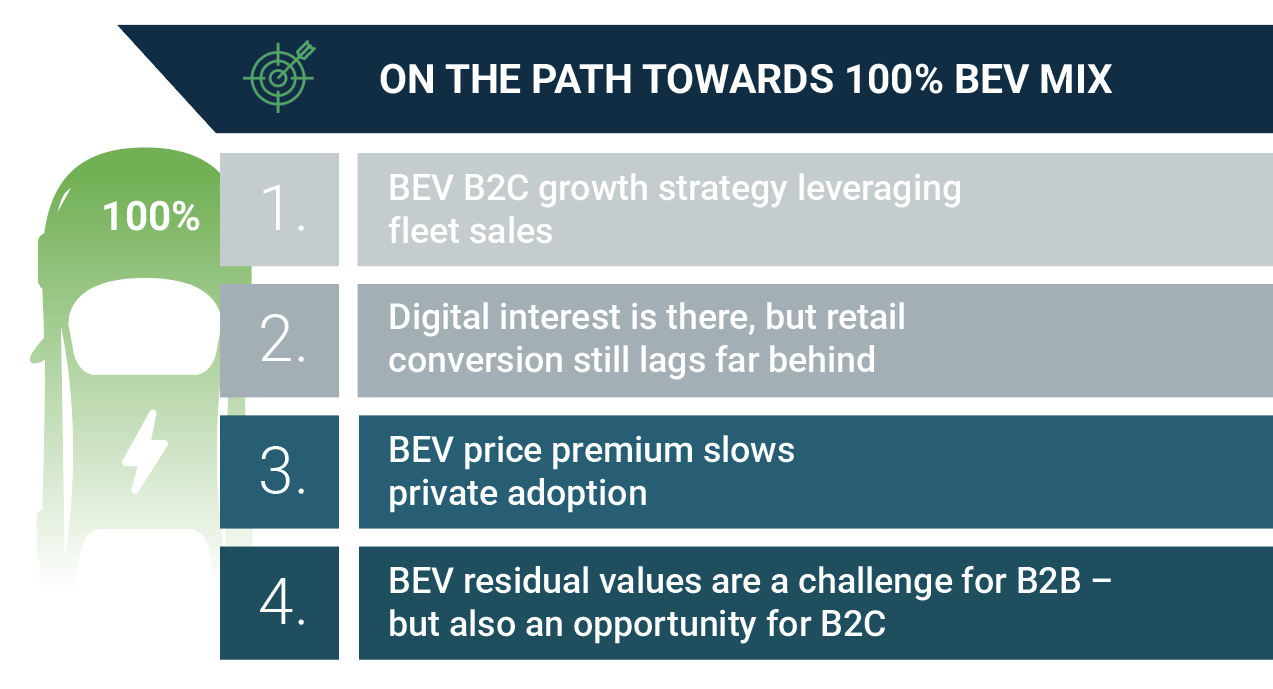NO TIME TO READ THIS WEBSITE?
WANT TO DISCOVER MORE?
SEARCH
WANT TO DISCOVER MORE?
SEARCH
attery electric vehicle (BEV) adoption is growing, but the momentum is uneven. While digital interest in BEVs is high—often three times higher than for internal combustion vehicles—this enthusiasm does not yet translate into retail sales.
In most major European markets, it is fleet customers, not private buyers, who are driving adoption. In Germany and the UK, more than 70 percent of new BEV registrations already come from fleet channels. For OEMs, fleets are therefore not just a sales engine, but a critical gateway to private demand.
Despite rising visibility, private adoption of BEVs remains constrained by a set of recurring barriers. Purchase prices (MSRP) are still up to 30 percent higher than comparable ICE models. Residual values lag as much as 32 percent behind ICE equivalents, undermining consumer confidence in resale. Charging infrastructure continues to be insufficient or unreliable, particularly outside urban centers, fueling range anxiety. On top of this, customers often face limited retail guidance—dealers are frequently better trained (and/or incentivized) to sell ICE products than to reassure hesitant EV buyers.
These obstacles are not just perception issues; they have tangible financial impact. In China, for example, an intensifying price war has pushed average BEV prices down by 30 percent in just twelve months, leaving consumers wary of resale stability. BYD in China offers the model Seagull for less than 7,000 € (vs. 22,990 in EU). In Europe, cross-market comparisons show BEVs carry a visible MSRP premium, leading many private buyers to abandon them early in the consideration funnel—even if leasing rates are sometimes more favorable – up to +50% less compared to equivalent ICE models.
(See also BEV Study 2025)
¹ Basic entry price for the vehicle class without consideration of comparable equipment features ; Excluded VAT and additional fees;
² 0€ deposit/ 10k km p.a.; 36month leasing period
Source: AlixPartners / Berylls by AlixPartners analysis; Leasingmarkt.de; Leasing.uk, truecar.com
By contrast, fleet adoption tells a different and more encouraging story. In Germany, more than two-thirds of BEVs registered belong to corporate fleets. In the UK, the figure is closer to 85 percent. Chinese OEMs are leveraging aggressive fleet strategies to establish a foothold in Europe, with the top five Chinese BEVs in Germany achieving a B2B market share growth of over 113 percent CAGR within a year.
Fleet channels matter because they lower the adoption barrier for individuals. Every corporate BEV has both a driver—who experiences e-mobility risk-free, often with strong tax benefits—and a future private buyer when the vehicle enters the used market.
“Fleet sales are a key driver of BEV penetration, supported by extended test-drive programs (four weeks) that can convert up to 50% of customers.”
- CCO EU, Volume OEMOff-lease BEVs thus create a pipeline of more affordable vehicles, critical to reaching price-sensitive mass-market customers.
“Intelligent management of total cost of ownership, residual values, and the used car market is essential to overcoming BEV adoption barriers”
- CSO, Premium OEMUnlocking private BEV demand requires tackling three interconnected issues: pricing, residual values, and customer trust. OEMs must narrow the MSRP gap with ICE models and communicate the advantages of lower operating costs more effectively. Leasing strategies should directly address residual value concerns, for example by introducing “battery health guarantees” that protect resale prices. Innovative financing, such as subscriptions or EV-specific leasing bundles with charging services, can also make EV ownership more predictable and attractive.
At the same time, used BEV markets need targeted support. Frequent model updates and rapid technological cycles depress residuals, creating skepticism among second-hand buyers. Proactive remarketing, certified pre-owned EV programs, and partnerships with auto banks can stabilize this market segment and build confidence.
The path to mass adoption will not be automatic. OEMs must actively convert fleet momentum into private sales by addressing the structural barriers that hold back retail customers. This means ensuring the digital-to-retail funnel does not break down—turning high online interest into real-world registrations through stronger test drive programs and better-trained retail staff. It also means adapting strategies by market: in Europe, leveraging corporate fleets as a launchpad; in China, navigating price volatility while defending brand equity; and in the US, ensuring competitive leasing and federal incentive alignment.
Fleets have adopted BEVs much faster – can we use that to unlock mass BEV acceptance?

Fleets are the launchpad, but not the endgame.
To secure lasting BEV adoption, OEMs must move beyond relying on corporate customers and unlock private demand through pricing discipline, residual value management, and innovative leasing solutions. Done right, this dual strategy will ensure that today’s corporate drivers become tomorrow’s private EV buyers—scaling electrification far beyond fleets and into the mass market.
NO TIME TO READ THIS WEBSITE?